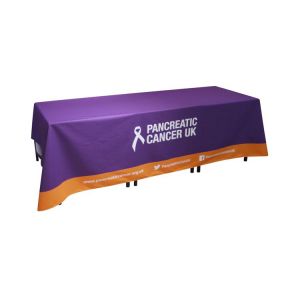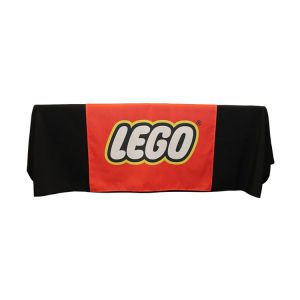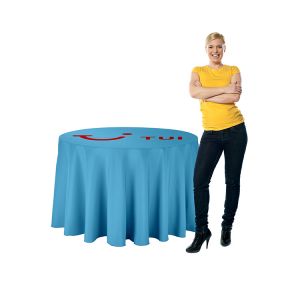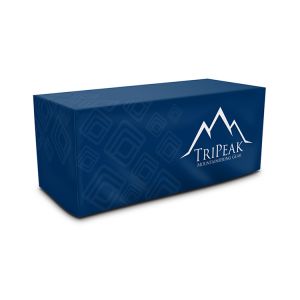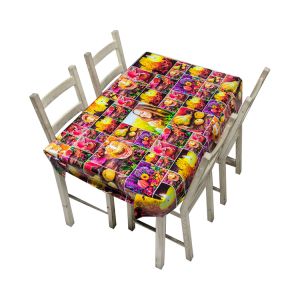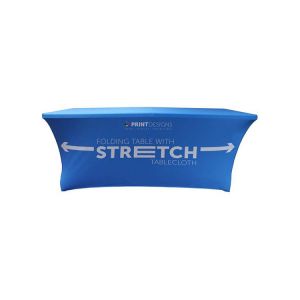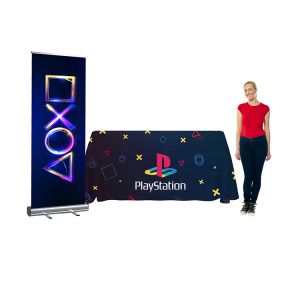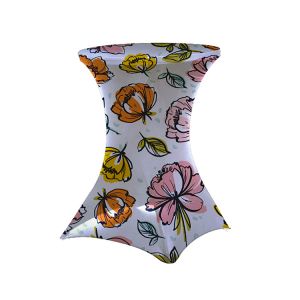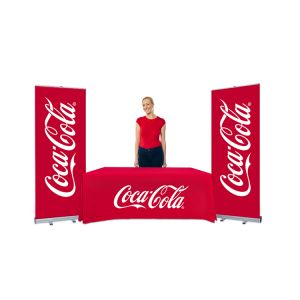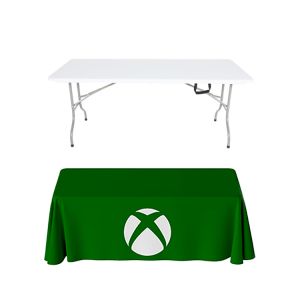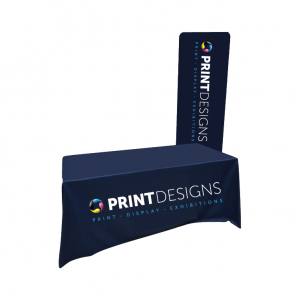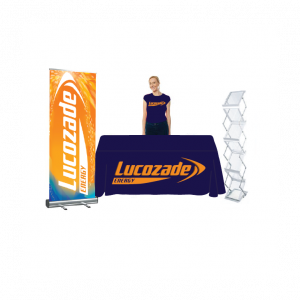What content can be printed onto a tablecloth?
We can print any content made from CMYK color at any position over the entire surface of the fabric of the tablecloth. Many customers tend to design artwork in a conventional way whereby critical viewable artwork content such as a logo or important wording is featured on the front 'drop' of the tablecloth but there is nothing preventing you from spreading your design all over the fabric if you wish.
Why not consider printing your tablecloth with a 'step and repeat' logo pattern all over the fabric or even a patterned or photographic background? The amount of colour you use in your artwork makes no difference to the cost so feel free to be as creative as you like!
What type of fabric is used for personalised tablecloths?
We use a 100% polyester fabric material that has a soft touch feel and the finish has a very slight lustre. Being a soft touch fabric, there is no stiffness or crispiness to our material which means that it drapes and hangs nicely. Although our fabric is relatively soft to begin with, we find that the more it is used, handled and washed; the more pliable and soft it becomes.
What process of printing do you use to produce your tablecloths?
The process of printing we use is called dye sublimation printing.
We start off by printing the artwork onto paper (in mirror image). After the image is printed onto the paper, it is passed through heated rollers with the fabric material sandwiced next to it.
As the paper and fabric pass around the heated rollers at around 200 degrees C, the ink that is printed onto the paper turns into gas and this dyes the image into the yarn of the fabric.
The printed image that is transferred to the fabric is waterfast, UV stable and highly durable. With our printing process, the fabic has the same 'feel' and texture all-over unlike tablecloths produced by ironing on a transfer!
Are printed tablecloths fire rated?
Yes, the fabric we use carries a DIN 4102 Class B1 rating. This complies with the requirements that are commonly required for use in public spaces within the UK and Europe. You can donwload a material specification sheet from the various product pages for printed tablecloths on our website.
Can you match Pantone colours?
Pantone colours (sometimes knows as spot colours) are pre-mixed coloured inks that are commonly used by lithographic or screen printing companies. Buying a pantone ink is rather like buying a ready mixed tin of paint off the shelf.
The process of printing we use is digital (CMYK printing). With our process of printing, cyan, magenta, yellow and black inks are combined in different ratios to create the final colour.
Many Pantone spot colours can be matched very closely by mixing together CMYK inks together but some Pantone colour contain special pigments that make them hard to reproduce. An example could be a metallic Pantone colour or perhaps a Pantone colour that is almost fluorescent in appearance.
So, some Pantone colours can be reproduced/matched quite closely but others cannot. If you have a particular Pantone colour that you want to print then the best thing is to get in touch. We can check our Pantone swatch book and advise if we can replicate the colour using our process of full colour printing.
What type of tablecloths can we produce?
There are lots of different types of covers that we can manufacture and these include:
Conventional printed tablecloths - to fit onto rectangular or square tables whereby the sides drape to the floor.
Fitted tablecloths - this type of tablecloth consists of a top section of material and four side panels that are sewn together to make a box type cover that drops over the table. As the fabric is made to measure, there is no pleating on the sides which hang flat to the floor.
Circular printed tablecloths - these are cut to a round shape and can be made at almost any diameter up to 3100mm. As you would expect, this shape of tablecloth is designed to be used with a table with a round top.
Stretch printed tablecloth - rather like a fitted tablecloth, this type of table covering is made from a top section and 4 side sections. The difference is that the fabric used is highly elastic. Rather than draping at the sides, the fabric is cut to a small size and is designed to pull and fit underneath the legs at the corners of the table. This is achieved by sewing small pockets at the bottom, inside corners of the tablecloth. Since stretch tablecloths have to be made to quite close tolerances to get the fit just right for the type of table they are to be used with, we tend to supply this type of printed tablecloth in conjuntion with the table itself (although we can also supply the tablecloths separately too).
Printed Table Runners - These are normally smaller, rectangular pieces of printed fabric. They can be hung on top of a conventional plain tablecloth to great visual effect. If you don't want to invest the money in a complete printed tablecloth, you can utilise a printed table runner with a plain cloth and still achieve a nice, personalised look to your display.
Can I use my printed tablecloth outdoors?
Yes, but if you use your tablecloth outdoors and it gets wet, we recommend washing it when you get home in order to remove any contaminants that might have fallen onto the fabric with the rain.
Printed tablecloths are not designed to be used outdoors for extended periods of time whereby exposure to strong UV light and the elements would cause them to deteriorate but short term use for an event for example should not cause any problems.
Can I wash my printed tablecloth?
Yes, you can wash our printed tablecloths in any conventional washing machine using standard detergent. We recommend washing at temperatures of up to 40 degrees only and you should not wash your tablecloth at the same time as other items.
Printed tablecloths should not be tumble dried. Instead, hang it to dry over a radiator, washing line of clothes airer and you will find that the fabric should dry quite quickly.
Can I iron or steam my printed tablecloth?
If you have stored your printed tablcloth folded for some time, the material can become creased. From experience, such creases tend to 'drop out' over time naturally but you may wish to remove them quickly for an event.
You can iron our tablecloths using any conventional iron at the appropriate heat setting for polyester fabric or a lot of our customers use a portable hand steamer to run over the fabric and remove creases.
How do I set up my artwork for a printed tablecloth?
You can find downloadable artwork templates for most standard tablecloths under the 'downloads' tab on the relevent product pages of our website. Our templates are normally available in PDF format so you can open them in most common graphic design packages.
Artwork templates will show things like the recommended viewable area (the front of the table) which will help you to position your artwork content appropriately. When you have completed your artwork, just remove any guidelines from the file before saving it.
Not everyone has the ability or software to put together 'print ready' artwork themselves or perhaps you just need some support and help. That's no problem because our team can give you free help and support over the phone, by email or online chat if you need it. We can also quote to handle the design fully for you if you wish.
Do we check artwork and send a proof of the artwork prior to printing?
Yes we do. After we receive your artwork, one of our team will check that the file you have provided is the correct size and scale for the type of tablecloth you have ordered. We will run the file through software that will convert the colour to CMYK so it is correct for our process of prining, then we will send a proof via email so you can check it.
If we spot anything on your artwork that we think is a cause for concern, we will let you know but please note that we don't make checks to spelling or grammar and we don't make specific checks for artwork quality.
In short, if we spot something that we think is an issue, we will let you know but if you are providing your own artwork for us to print from you should make appopriate checks to the artwork for spelling, grammar, quality and positioning before you send it to us.
We are happy to advise though so if you want to run something by us or get a second opinion on something, just get in touch!
Are our printed tablecloths eco friendly?
The material we use for the production os our printed tablecloths is made from 100% polyester which means it can be commonly recycled with other textiles.
The ink that we use for printing is water based and it does not contain any solvents (VOC's) that are considered to be environmentally harmfull.
The thread that we use for sewing is polyester based rather than cotton so the tablecloth is made only from one material. Polyester thread is also stronger.
Our tablecloths can be used for many years again and again because they are durable. They are a far more environmentally friendly proposition than throw-away/disposable products that need to be replaced.
When you want to dispose of your tablecloth you should be able to recycle it at most household recyling centres or should you wish to, you can send it to us and we will recycle it responsibly for you along with our other textile waste products.



